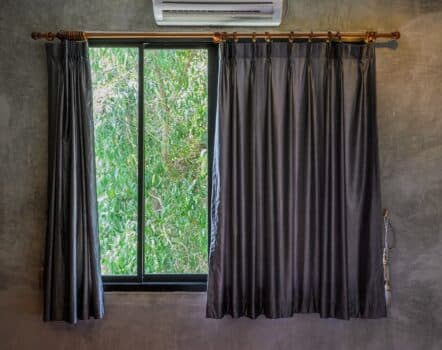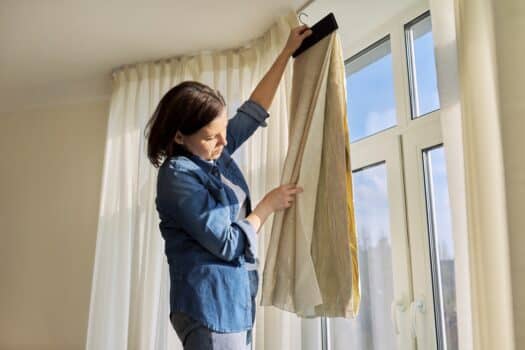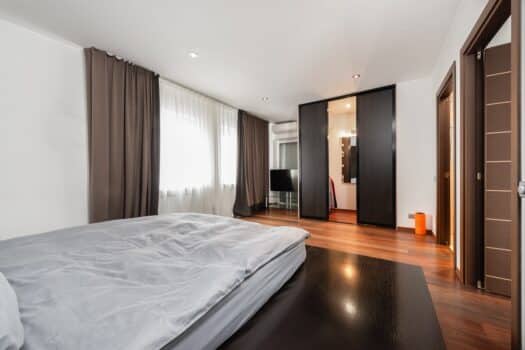In a fix while choosing the best blackout curtains from the scores of options online?
How about making one on your own? Though coming up with DIY curtains can seem complicated at first, we’re sure you would think differently once we take you through some of the simplest procedures.
Rest assured, the curtains will turn out just as effective and visually appealing as any readymade option and will save you quite a few bucks! So, without further ado, let’s start with this comprehensive guide on blackout curtains and how to make them from scratch.
Before we begin, checkout our older articles on various interesting topics such as undermount sinks have faucet holes, chrome spray paints, install vessel sink faucet, and many more.
Without further ado! Let’s begin.
How To Make Blackout Curtains

Before we head on to the procedure, let’s learn about some essentials of blackout curtains to have a clear idea about their functioning and properties.
How Do Blackout Curtains Work?
A blackout drape or curtain might seem a futuristic idea, but the science behind these curtains is, in effect, quite simple.
These are regular drapes having a lining or back made of a specific type of fabric that’s tightly woven. Such a design prevents UV rays and natural light from penetrating the drapes, resulting in a pitch-black room that’s an ideal environment for napping anytime.
Curtains that darken rooms can keep away 99.9% natural light when hung correctly. Their design and composition make them multi-seasonal, so rest assured you can enjoy their benefits around the year.
Blackout Curtains vs Regular Drapes
You’ll know that the curtains we use are typically one-layer fabrics popular for their ability to filter some light into the room.
As for the blackout varieties, these come with room-darkening attributes that result in a much thicker fabric. A surprising fact is that they’re still quite light in terms of their appearance and weight.
On the other hand, drapes comprise multiple layers and are hence much thicker and heavier. These do come with light-reducing properties, but a layer of blackout fabric is what produces this effect.
Simply put, while drapes have one layer as a blackout fabric, blackout curtains are blackout fabrics in themselves.
Benefits Of Blackout Curtains
Here are the many benefits of installing a blackout curtain in a room:
1. Good Insulation And Energy Efficiency
Did you know that the transmission of heat through windows may cause a minimum of one-third of the energy wastage in an average home? In turn, this leads to an increase in energy consumption by the cooling and heating system in the home.
Adding a blackout curtain in such rooms insulates them efficiently to reduce heat loss to a large extent. Some experts claim that correctly designed curtains can help curtail heat loss by 25%, significantly reducing your power bills in the process.
2. Blocks The Light
The backside of blackout curtains is made of many layers of heavy and tightly woven fabric that’s totally opaque. A soothing and soft light will still stream into the room through those curtains, making the atmosphere immensely relaxing.
That’s why these curtains will provide the perfect shade for people working night shifts.
Also, in case you have a separate home theater set-up with a TV at home, installing a blackout curtain can help recreate the atmosphere in a theater accurately.
3. Versatile Design
Blackout curtains can cool down your home during the summer season by regulating heat and blocking the sunlight. Alongside, these can retain the warmth within and keep the cold out during winter.
These are generally seen in period homes and are ideal for the single-glazed windows therein. Thanks to their versatility, you can utilize them around the year.
4. Reduces Noise
Another interesting feature of these curtains is their ability to reduce street noise significantly. Made using thick fabric and an additional back lining, they provide efficient noise insulation throughout.
This lets you have a sound sleep throughout— though the curtains don’t block disturbances completely, they can make the atmosphere much more peaceful.
5. Protects Privacy
Due to the prevalent use of see-through windows and doors in today’s homes, your privacy may be compromised if you’re living in a heavily populated neighborhood. Blackout curtains are the ideal alternative in this regard, as their opaque fabric filters heat and light while darkening the room and concealing most stuff.
6. Protects The Room Furnishings
Rooms that face the north require regular redecoration as the intense, penetrating sunlight ages furniture, dulls wall paints, and fades curtain and carpet fabrics. Using a blackout curtain in such areas can help keep the home warmer during winter and cooler during summer, reducing the time spent refinishing and repainting.
Make sure to close the room curtains through the day, particularly when the sun is the strongest, and open them as the evening approaches.
Styles For Blackout Curtains
Now, let’s look at some popular styles for blackout drapes that can uplift the visual appeal of the space considerably:
- Tab Top: Curtains hang from a loop from the rod.
- Rod Pocket: A slit in the curtain enables slip-on insulation.
- Pinch Pleats: The fabric comes with a pinch at the top so that the curtain appears pleated.
- Grommet: Looping fabric and metal rings are used to install curtain headers.
Lining Options For Blackout Curtains
- Thermal lined: It comes with a backing of heat-trapping fabric to retain the warmth of the room but might not be 100% opaque.
- Blackout-lined: This variety is made from a heavier polyester lining to form a stiff drape.
- Foam-backed: It might not be totally opaque but retains the soft folds of the blackout drape.
- Privacy-lined: This refers to a poly-cotton blend that’s soft to the touch.
Choosing The Fabric For Blackout Curtains

At any store for curtain fabrics, both online and offline, you’ll find quite a few varieties of blackout fabric to choose from. Here’s what you’ll need to keep in mind while choosing the best-suited fabric for your needs:
1. Color
You’ll want to get a curtain that matches your style and décor preferences, so fabric color is one of the primary considerations. While black curtains do have maximum room-darkening power, you don’t necessarily have to use black fabric for the purpose.
Go for a fabric that looks good with your room décor. Do note that heavyweight poly/cotton and polyester fabrics are available in different prints and colors. As such, you shouldn’t have any problem finding the fabric suitable for your needs.
2. Fabric Weight And Type
If noise dampening or insulation aren’t major lookouts for you, choosing a heavyweight poly/cotton blend or polyester fabric won’t be a problem. Just ensure that you check the weight beforehand if you don’t have a fair idea about the same.
The heaviest fabrics weigh around 359+ GSM and have a tightly-woven format. Speaking of lightweight options like sheer, they aren’t ideal for making blackout curtains as they’re loosely woven and less light-resistant.
But you can pair sheer fabrics with blackout curtains for better temperature regulation within any space. We’ll discuss how to combine sheer and blackout curtains later on in the article.
Choosing the right fabric type is another important factor, as it will affect their ability to prevent the entry of sunlight. We can vouch that all good-quality blackout fabrics will block out light effectively.
Furthermore, you’ll have to look for any mention of insulation and noise-dampening qualities if they’re there on your checklist.
How To Make DIY Blackout Curtains
Once you’ve gathered a few tools and materials, designing and putting up a blackout curtain by yourself can be fun! So, let’s look at some simple ways to get through the job:
1. Sewing A Blackout Curtain
Materials You’ll Need
Here’s what you’ll need for sewing and putting up a curtain:
- Blackout Lining
Ensure the curtain lining you’re using is of top-notch quality to ensure it delivers the desired results. Keep in mind that most efficient varieties are made of white, thick cotton.
- Printed Fabric
You’ll need around six yards of printed fabric of your choice, but the exact requirements will depend upon the window size.
- Thread
When it comes to sewing curtain fabric, it’s best to choose a white thread.
- Iron
To ensure the stitched portions of the curtain appear clean and crisp, it’s essential to press the corners and edges of the fabric before sewing.
- Marker
Have a market by your side to quickly make markings on the fabric. You may even use a pencil for this purpose.
- Packs of pins
Pins will help hold the fabric in place till it’s ready for sewing.
- Meter Stick
While rulers will be too short for the job, measuring tapes might not be stable and flat enough. A yardstick is the best alternative, as it’s lightweight, flat, and helps provide reliable measurements.
- Scissors
Choose a pair of heavy-duty, sharp scissors specialized for cutting fabric. Ensure that it uses stainless steel blades for durability and precision.
The Method
Step 1: Measuring & Cutting The Fabric
Begin by measuring the windows — start from the rod for hanging curtains and measure 6 inches beneath the windowsill.
Each curtain should cover a window completely to ensure no light can get in from the outdoors. As such, it’s essential to ensure the length of the fabric is enough to cover the windows completely. Get a tape measure for this step, and take down all the measurements on a notepad.
Also, remember that you’ll need a longer curtain piece as it must be folded over the curtain top twice to create a loop for the rod.
Step 2: Taking The Side To Side Measurement
Now, you’ll need to ensure the curtain completely covers the window sidewise. Measure the window side to side, starting from the external edge on one side to the other, Also, do leave some space for hems on the side.
Step 3: Adding To The Fabric
Once you’ve figured out the measurements for the external edges of the windowsill, add around 8 inches to each dimension and cut the curtain fabric accordingly. This will make sure you have enough fabric for hemming the curtains. For instance, windows measuring 42 x 60 inches will require a 50 x 68-inch curtain.
Step 4: Cutting The Blackout Fabric
Firstly, the blackout fabric piece doesn’t have to be of the same size as the printed curtain fabric since you’re just using it to line the curtains.
Cut this lining fabric using the dimensions of the window that you took down earlier. For a window that’s 42 x 60 inches, you should cut the fabric exactly to these dimensions. Consider adding around 2 inches of leeway with this length of the fabric.
Step 5: Ironing The Fabrics
If necessary, you can iron both the printed and the blackout fabrics at this point. Remember that proper ironing is essential for wrinkled fabrics to ensure they don’t look out of place. Here’s another word of caution: you’ll need to activate the lowest setting on the iron and complete the work in sections.
Also, if you’ve chosen a softer fabric for the top layer of the curtains, place a t-shirt or towel on top of the fabric before you start with the ironing.
Step 6: Centering And Cutting The Fabrics For The Panels
Spread out the printed fabric (with the printed side facing downwards). Now, place the blackout fabric over the former and center it properly. Although the blackout fabric should appear the same on both sides, one side might look a little glossier and should be visible.
Make sure the edges of the curtain fabric and the blackout fabric are equally spaced all along their length and breadth. On a side note, it’s essential to spread out both fabrics to the fullest — you’ll need to tug on their edges to smoothen them as necessary.
At this point, you’ll have to cut the fabrics again if you intend to make two curtain panels.
Locate the center point of the curtain pieces and draw a line through the center along the width of the curtain. Follow this by placing a few pins along this line so that the two fabric pieces are sewn together. You’ll then need to cut down this line using scissors. After you’re done cutting the pieces of blackout fabric, re-center them on the printed fabric.
Step 7: Folding the edges of the outer fabric
Take one edge of the printed fabric and make a fold till 2 inches towards the center so that it coincides with the edges of the blackout fabric. Repeat this step for every side of the printed fabric. Keep in mind that the blackout fabric will face towards the window. You should also ensure that folds have their edges lined up with the fabric.
Step 8: Pinning The Fabrics Together
Next, pin the folded edges of the printed fabric to secure it to the blackout fabric till you’re ready to sew them. You’ll need to insert pins at a gap of 3 inches along the folds.
The pins should go from their outer edge and inwards towards the fabric center. That way, you can avoid sewing over any pin and can also remove it easily while sewing each section.
Step 9: Sewing The Fabrics
Finally, you can begin sewing the printed and blackout fabrics, beginning with the raw edge of the former. The setting for straight stitches will be perfect for the job. Make sure the stitches are on the inward edges in the folded area but around 0.5-inch far from the raw edges of the curtain fabric.
Likewise, create another straight stitch along the outer edge of the folds. You’ll need to turn and keep on sewing the stitch around the fabric edges.
Now, you’ll have to secure the ultimate stitch on the curtain hem, so press the reverse lever on one side of the sewing machine. Keep pressurizing the pedal lightly while holding the lever so that you’re able to reverse the direction of the stitch. Then backstitch up to 2 inches and release the lever. In the same way, you’ll have to sew till the last curtain edge.
The curtain is now equipped to block out sunlight effectively. You’ll just have to create the loops for hanging it now.
Step 10: Creating The Loop
Start by folding over 3 inches from the top of the fabric — this will make sure the edge is hidden on the wrong side of the curtain and provide enough room for the rod. Ensure that the folded part of the curtain fabric is aligned with the edges of the fabric on both sides.
At this point, you can check whether the curtain rod fits comfortably through the loop created by the folding. If it doesn’t, you can add another inch to the fold. It will also do good to press the edge using your hand to remove all the creases.
Step 11: Inserting Pins To Keep The Folded Fabric In Place
Again, you can place pins every 3 inches so that the folds stay in place. Remember to insert pins perpendicular to the edge of the curtain fabric.
Step 12: Sewing the fold from the hemmed edges
After this, you can start sewing a stitch at a distance of 0.5 inches from the hems. This will keep the fold protected and allow you to insert the rod through the fold. Finally, sew the stitch right across the other side.
Step 13: Backstitching to secure the final stitch
Create a backstitch just as you did to secure the last edge of the fabric hem. Then press the lever and hold it to ensure the sewing machine reverses direction while you’re holding the pedal.
Follow this by releasing the lever and making another forward stitch till the end. And after you’re done with these stitches, spin all stray threads so that the edges get a clean look. You’re all set to hang the curtains now!
2. Making A No-Sew Blackout Curtain
Some homeowners may not be able to devote enough time to sewing multiple stitches. Moreover, they might turn out erroneous if they’re completed hastily. The best alternative in such cases is making a no-sew version of blackout curtains — it’s super-easy to make and will be just as effective as sewed curtains.
So, let’s move on to the details of the procedure.
Materials You’ll Need
- Printed fabric or curtains
- Straight pins
- Blackout fabric
- Iron-on adhesive
- Handheld iron
- Tape measure
- Scissors
The Method
Before you purchase the above supplies, we’d suggest measuring your curtains accurately. For example, curtains that are 84-inch long will require 3 yards of blackout fabric.
Step 1
Start by applying the iron-on adhesive along the top hem on the backside of the curtain fabrics. This will help avoid any dimpling or pulling after the blackout fabric lining is attached. Ultimately, the fabric can fall naturally without any alteration in its shape.
Step 2
Measure the top edge of the curtain backside to cut a proper length of the iron-on adhesive. Now, pull the blackout fabric placed on the top hem and place the adhesive in such a way that it’s sandwiched between the blackout fabric and the curtain.
Step 3
Follow this by inserting straight pins along the curtain backside so that the blackout fabric, curtain fabric, and iron-on adhesive stay in place. You’ll then have to set the iron to the “wool” setting and press and hold it on the backside of the blackout fabric.
A point worth noting is that you may have to hold the iron onto the blackout fabric for longer than the recommended 20 seconds based on the thickness of the curtain fabric. Generally, a layer of damp cloth is added between the fabric and the iron to ensure it doesn’t get burned.
We’d suggest testing this step on a small area beforehand to understand what’s best suited for the fabric you’re using.
Once the backside of the curtain fabric has bonded firmly to the blackout fabric, make sure to trim any excesses carefully. Your curtains are now ready to be put up.

How To Make Blackout Curtains Frequently Asked Questions ?
How should you combine sheer and blackout curtains for maximum comfort?
Place sheer curtains close to the glass panels of your windows while fixing blackout curtains towards the room interiors.
In the summer months, opening the blackout curtains during the daytime will allow natural light to flow through. You can close the sheer curtains to soften the harsh sun rays so that the room doesn’t feel too hot.
As for the winter season, it’s best to keep the sheer curtain open to allow maximum light to flow into the room. When the evening arrives, closing the blackout curtains will help you maintain privacy and warmth within the room.
Can you dry clean blackout curtains?
A dry clean isn’t ideal for blackout curtains since the process requires applying intense heat. Instead, you can spot clean them using a damp soapy cloth. We’d recommend checking the fabric label or asking your dry cleaner whether the curtains require intense cleaning.
Do you need to press blackout curtains periodically even after they’re put up?
Blackout curtains can develop creases anytime, so it’s essential to maintain them regularly even after you’ve hung them on the windows. But you might not want to detach them now and then for ironing, so here’s how to get creases out of blackout curtains while they’re hanging:
- Fill a clean spray bottle with plain water or a wrinkle-removing solution.
- Spray the curtains wherever you find wrinkles
- Repeat the process after 24 hours if you still find some wrinkles left
The dampness of the solution, coupled with the weight of the curtain, will cause the wrinkles to smooth out within a maximum of a few days.
Are blackout curtains good for a baby’s room?
Infants and babies require much more sleep than adults as it’s essential for their development. Blackout curtains can help babies get a peaceful night’s sleep by preventing the entry of UV rays and natural light into their room. You can even use these curtains to sleep-train your toddlers by creating an inviting sleeping space.

How To Make Blackout Curtains Final Thoughts
Ready to make your own blackout curtains? So, gather all the tools and materials, read through the process once more if needed, and begin!
Not only do blackout curtains provide the perfect sun and noise protection to a space, but they also add sophistication to the ambiance. This versatility makes them one of the most practical options when it comes to adding curtains to any room.
Before we call it a day, here’s one last tip for you — if you’re planning on a more cost-effective approach to the DIY method, consider using some existing curtains for the top fabric. It’ll be great if you’ve already got pencil pleat curtains, as they’ll make for eye-catching blackout curtains for any space.
See you next time!


